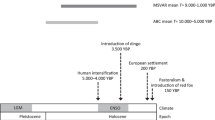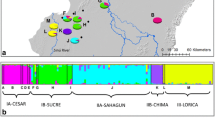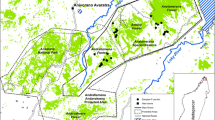Abstract
Many endangered species worldwide are found in remnant populations, often within fragmented landscapes. However, when possible, an understanding of the natural extent of population structure and dispersal behaviour of threatened species would assist in their conservation and management. The brush-tailed rock-wallaby (Petrogale penicillata), a once abundant and widespread rock-wallaby species across southeastern Australia, has become nearly extinct across much of the southern part of its range. However, the northern part of the species’ range still sustains many small colonies closely distributed across suitable habitat, providing a rare opportunity to investigate the natural population dynamics of a listed threatened species. We used 12 microsatellite markers to investigate genetic diversity, population structure and gene flow among brush-tailed rock-wallaby colonies within and among two valley regions with continuous habitat in southeast Queensland. We documented high and significant levels of population genetic structure between rock-wallaby colonies embedded in continuous escarpment habitat and forest. We found a strong and significant pattern of isolation-by-distance among colonies indicating restricted gene flow over a small geographic scale ( <10 km) and conclude that gene flow is more likely limited by intrinsic factors rather than environmental factors. In addition, we provide evidence that genetic diversity was significantly lower in colonies located in a more isolated valley region compared to colonies located in a valley region surrounded by continuous habitat. These findings shed light on the processes that have resulted in the endangered status of rock-wallaby species in Australia and they have strong implications for the conservation and management of both the remaining ‘connected’8 brush-tailed rock-wallaby colonies in the northern parts of the species’8 range and the remnant endangered populations in the south.
Similar content being viewed by others
References
Browning TL, Taggart DA, Rummery C, Close RL, Eldridge MDB (2001) Multifaceted genetic analysis of the “Critically Endangered” brush-tailed rock-wallaby Petrogale penicillata in Victoria, Australia: Implications for management. Conserv. Genet. 2:145–156
Carter K, Goldizen AW (2003) Habitat choice and vigilance behaviour of brush-tailed rock-wallabies (Petrogale penicillata) within their nocturnal foraging ranges. Wildl. Res. 30:355–364
Cegelski CC, Waits LP, Anderson NJ (2003) Assessing population structure and gene flow in Montana wolverines (Gulo gulo) using assignment-based approaches. Mol. Ecol. 12:2907–2918
Clancy TF, Close RL (1997) The Queensland rock-wallabies – an overview of their conservation status, threats and management. Aust. Mammal. 19:169–174
Cornuet JM, Piry S, Luikart G, Estoup A, Solignac M (1999) New methods employing multilocus genotypes to select or exclude populations as origins of individuals. Genetics 153:1989–2000
Danley PD, Markert JA, Arnegard ME, Kocher TD (2000) Divergence with gene flow in the rock-dwelling cichlids of Lake Malawi. Evolution 54:1725–1737
Department of Environment and Conservation NSW (2005) Draft Recovery Plan for the Brush-tailed Rock-wallaby Petrogale penicillata. DEC, Sydney
Dieckmann U, O’8Hara B, Weisser W (1999) The evolutionary ecology of dispersal. Trends Ecol. Evol. 14:88–90
Dovey L, Wong V, Bayne P (1997) An overview of the status and management of rock-wallabies (Petrogale) in New South Wales. Aust. Mammal. 19, 163–168
El Mousadik A, Petit RJ (1996) High level of genetic differentiation for allelic richness among populations of the argan tree Argania spinosa (L) Skeels endemic to Morocco. Theor. Appl. Genet. 92:832–839
Eldridge MDB, Kinnear JE, Onus ML (2001) Source population of dispersing rock-wallabies (Petrogale lateralis) identified by assignment tests on multilocus genotypic data. Mol. Ecol. 10:2847–2876
Eldridge MDB, Rummery C, Bray C, Zenger KR, Browning TL, Close RL (2004) Genetic analysis of a population crash in brush-tailed rock-wallabies (Petrogale penicillata) from Jenolan Caves, south-eastern Australia. Wildl. Res. 31:229–240
Eldridge MDB, King JM, Loupis AK, Spencer PBS, Taylor AC, Pope LC, Hall GP (1999) Unprecedented low levels of genetic variation and inbreeding depression in an island population of the black-footed rock-wallaby. Conserv. Biol. 13:531–541
Evanno G, Regnaut S, Goudet J (2005) Detecting the number of clusters of individuals using the software STRUCTURE: A simulation study. Mol. Ecol. 14:2611–2620
Falush D, Stephens M, Pritchard JK (2003) Inference of population structure using multilocus genotype data: Linked loci and correlated allele frequencies. Genetics 164:1567–1587
Felsenstein J (1993) PHYLIP. University of Washington, Seattlefs, WA
Frankham R, J.D. B, Briscoe DA (2002) Introduction to Conservation Genetics. Cambridge University Press, Cambridge
Goudet J (1995) FSTAT (Version 1.2): A computer program to calculate F-statistics. J. Hered. 86:485–486
Greenwood PJ (1980) Mating systems, philopatry and dispersal in birds and mammals. Anim. Behav. 28:1140–1162
Guo SW, Thompson EA (1992) Performing the exact test of Hardy–Weinberg proportion for multiple alleles. Biometrics 48:361–372
Hanski I (2001) Population dynamic consequences of dispersal in local populations and in metapopulations. In: Clobert J, Danchin E, Dhondt AA, Nichols JD (eds) Dispersal. Oxford University Press, New York, pp 283–298
Hazlitt SL, Eldridge MDB, Goldizen AW (2004) Fine-scale spatial genetic correlation analyses reveal strong female philopatry within a brush-tailed rock-wallaby colony in southeast Queensland. Mol. Ecol. 13:3621–3632
Hoffman JI, Amos W (2005) Microsatellite genoty** errors: detection approaches, common sources and consequences for paternal exclusion. Mol. Ecol. 14:599–612
Hood GM (2003) PopTools version 2.6.2. Available on the internet. URL http://www.cse.csiro.au/poptools/
Jarman PJ, Bayne P (1997) Behavioural ecology of Petrogale pencillata in relation to conservation. Aust. Mammal. 19:219–228
Kraaijeveld-Smit FJL, Lindenmayer DB, Taylor AC (2002) Dispersal patterns and population structure in a small marsupial, Antechinus agilis, from two forests analysed using microsatellite markers. Aust. J. Zool. 50:325–338
Laws RJ, Goldizen AW (2003) Nocturnal home ranges and social interactions of the brush-tailed rock-wallaby Petrogale penicillata at Hurdle Creek, Queensland. Aust. Mammal. 25:169–176
Lim TL, Giles JR (1987) Studies on the yellow-footed rock-wallaby, Petrogale xanthropus Gray (Marsupalia: Macropodidae) III. Distribution and management in Western New South Wales. Aust. Wildl. Res. 14:147–161
Lowe A, Harris S, Ashton P (2004) Ecological Genetics: Design, Analysis, and Application. Blackwell Science Ltd., Oxford
Lunney D, Law B, Rummery C (1997) An ecological interpretation of the historical decline of the Brush-tailed Rock-wallaby Petrogale penicillata in New South Wales. Aust. Mammal. 19:281–296
Manel S, Berthier P, Luikart G (2002) Detecting wildlife poaching: identifying the origin of individuals with Bayesian assignment tests and multilocus genotypes. Conserv. Biol. 16:650–659
Manel S, Gaggiotti OE, Waples RS (2005) Assignment methods: matching biological questions with appropriate techniques. Trends Ecol. Evol. 20:136–142
Maruyama T, Fuerst PA (1985) Population bottlenecks and nonequilibrium models in population genetics 3. Genic homozygosity in populations which experience periodic bottlenecks. Genetics 111:691–703
McCallum HI (1997) Rock-wallaby biology and management: synthesis and directions for future research. Aust. Mammal. 19:319–324
Nei M (1978) Estimation of average heterozygosity and genetic distance from a small number of individuals. Genetics 89:583–590
Nei M, Maruyama T, Chakraborty R (1975) Bottleneck effect and genetic variability in populations. Evolution 29:1–10
Paetkau D, Calvert W, Stirling I, Strobeck C (1995) Microsatellite analysis of population structure in Canadian polar bears. Mol. Ecol. 4:347–354
Page RD (1996) TreeView: An application to display phylogenetic trees on personal computers. Comput. Appl. Biosci. 12:357–358
Pearse DE, Crandall KA (2004) Beyond F ST: Analysis of population genetic data for conservation. Conserv. Genet. 5:585–602
Piry S, Alapetite A, Cornuet JM, Paetkau D, Baudouin L, Estoup A (2004) GENECLASS2: A software for genetic assignment and first-generation migrant detection. J. Hered. 95:536–539
Poole WE, Catling PC (1974) Reproduction in two species of grey kangaroos, Macropus giganteus (Shaw) and Macropus fuliginosus (Desmarest) 1. Sexual maturity and estrus. Aust. J. Zool. 22:277–302
Pope LC, Sharp A, Moritz C (1996) Population structure of the yellow-footed rock-wallaby Petrogale xanthopus (Gray, 1854) inferred from mtDNA sequences and microsatellite loci. Mol. Ecol. 5:629–640
Pope LC, Estoup A, Moritz C (2000) Phylogeography and population structure of an ecotonal marsupial, Bettongia tropica, determined using mtDNA and microsatellites. Mol. Ecol. 9:2041–2053
Pope LC, Blair D, Johnson CN (2005) Dispersal and population structure of the rufous bettong,Aepyprymnus rufescens (Marsupialia : Potoroidae). Austral. Ecol. 30:572–580
Pritchard JK, Stephens M, Donnelly P (2000) Inference of population structure using multilocus genotype data. Genetics 155:945–959
Raymond M, Rousset F (1995) An exact test for population differentiation. Evolution 49:1280–1283
Rice WR (1989) Analyzing tables of statistical tests. Evolution 43:223–225
Rossiter SJ, Jones G, Ransome RD, Barrattt EM (2000) Genetic variation and population structure in the endangered greater horseshoe bat Rhinolophus ferrumequinum. Mol. Ecol. 9:1131–1135
Sharp A (1997) Insights into the dispersal patterns of yellow-footed rock-wallabies, Petrogale xanthopus. Aust. Mammal. 19:229–238
Short J (1990) Distribution and status of the brush-tailed rock-wallaby in south-eastern Australia. Aust. Wildl. Res. 17:169–180
Short J, Smith A (1994) Mammal decline and recovery in Australia. J. Mammal. 75:288–297
Sigg DP, Goldizen AW, Pople AR (2005) The importance of mating system in translocation programs: reproductive success of released male bridled nailtail wallabies. Biol. Conserv. 123:289–300
Smith JNM, Hellmann JJ (2002) Population persistence in fragmented landscapes. Trends Ecol. Evol. 17:397–399
Sokal RR, Rohlf FJ (1995) Biometry: the Principles and Practice of Statistics in Biological Research. W.H. Freeman & Co., New York
Strahan R (eds) (1995) The Mammals of Australia. Reed Books, Australia
Sunnucks P (2000) Efficient genetic markers for population biology. Trends Ecol. Evol. 15:199–203
Sunnucks P, Hales DF (1996) Numerous transposed sequences of mitochondrial cytochrome oxidase I-II in aphids of the genus Sitobion (Hemiptera: Aphididae). Mol. Biol. Evol. 13:510–524
Taylor AC, Sherwin WB, Wayne RK (1994) Genetic variation of microsatellite loci in a bottlenecked species – the northern hairy-nosed wombat Lasiorhinus krefftii. Mol. Ecol. 3:277–290
Weir BS, Cockerham CC (1984) Estimating F-statistics for the analysis of population structure. Evolution 38:1358–1370
Yeh FC, Yang R-C, Boyle TJB, Ye Z-H, Mao JX (1997) POPGENE, the user-friendly shareware for population genetic analysis. Molecular Biology and Biotechnology Centre, University of Alberta, Canada. Available at URL http://www.ualberta.ca/∼ ∼fyeh/
Zenger KR, Eldridge MDB, Cooper DW (2003) Intraspecific variation, sex-biased dispersal and phylogeography of the eastern grey kangaroo (Macropus giganteus). Heredity 91:153–162
Acknowledgements
We thank all the private land owners for access to their properties and we are indebted to D. Sigg, J. Carter, K. Carter, R. Laws, N. Wynd, T. Barnes and numerous volunteers for help with trap** and field work over the course of this study. We are grateful to Queensland Parks and Wildlife Service and the Toowoomba City Council, including R. Laws, G. Maags, G. Lundi-Jenkins, P. Johnson, R. Hobson, M. Ready and N. Hyslop for in-kind support and samples. In particular, we wish to thank J. Rayner for help with fieldwork and for his local knowledge of rock-wallabies. We are indebted to the School of Integrative Biology Molecular Zoology and Gene Flow Labs for help with the molecular work, and D. Sigg, J. Nicholls, W. Telfer, P. Macqueen and two anonymous reviewers for constructive criticisms on earlier drafts of this manuscript. This study was approved by the University of Queensland Animal Ethics Committee and the Queensland Parks and Wildlife Service (Scientific Purposes Permit # W4/002560/00/SAA). This research was funded by the Australian Research Council, the National Geographic Society, the Norman Wettenhall Foundation, the University of Queensland and the Australian Commonwealth.
Author information
Authors and Affiliations
Corresponding author
Rights and permissions
About this article
Cite this article
Hazlitt, S.L., Goldizen, A.W. & Eldridge, M.D.B. Significant patterns of population genetic structure and limited gene flow in a threatened macropodid marsupial despite continuous habitat in southeast Queensland, Australia. Conserv Genet 7, 675–689 (2006). https://doi.org/10.1007/s10592-005-9101-x
Received:
Accepted:
Published:
Issue Date:
DOI: https://doi.org/10.1007/s10592-005-9101-x




